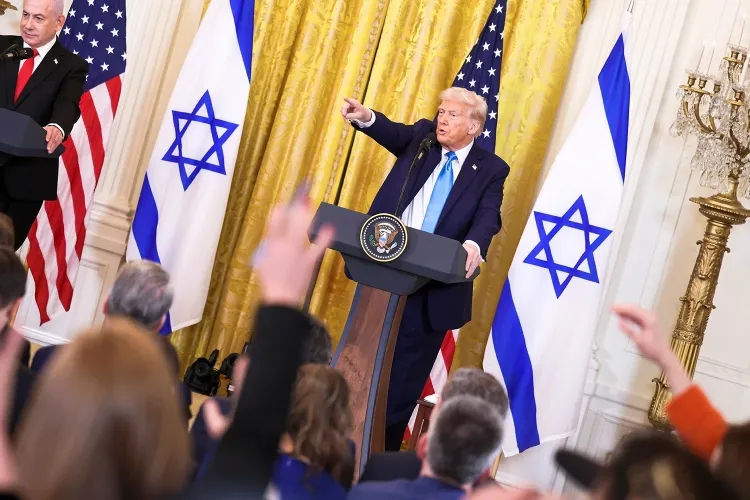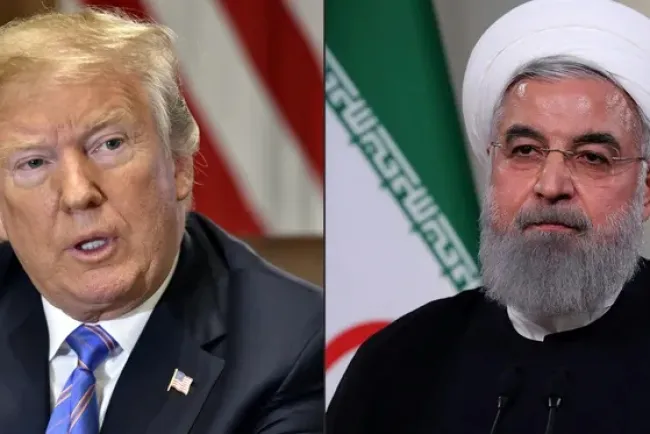Trump’s Controversial Gaza Proposal Sparks Outrage and Raises Diplomatic Tensions
In a provocative and contentious statement, U.S. President Donald Trump proposed a bold plan for the post-war future of Gaza, which would see the U.S. take control of the Palestinian enclave. Trump’s suggestion, made during a joint press conference with Israeli Prime Minister Benjamin Netanyahu, has sent shockwaves across the globe, particularly within the Arab world, where it has been widely rejected. The plan, which envisions transforming Gaza into a tourist and economic hub under American control, has raised significant concerns about its legality, morality, and the future of Palestinian self-determination.

Trump’s Vision for Gaza: An American Beach Strip?
Trump’s vision for Gaza involves the U.S. taking full control of the area, dismantling the existing infrastructure, and transforming the region into a resort-like destination with job opportunities and housing for displaced individuals. The U.S. would be responsible for clearing the dangerous unexploded ordnance, leveling the site, and rebuilding it as an economic development zone. However, Trump’s suggestion comes with a controversial twist: he envisions displacing the current Palestinian population and relocating them elsewhere, potentially out of Gaza entirely.
In his remarks, Trump stated, “We will take over the Gaza Strip and we will do a job with it too… level the site and get rid of the destroyed buildings, create economic development that will supply unlimited numbers of jobs and housing for the people of the area.” He added that the Palestinians, currently enduring violence and hardship in Gaza, should be resettled in new areas where they could live peacefully, free from the threat of violence.
While Trump’s proposal reflects his ongoing tendency to make bold and unorthodox statements, it has sparked outrage for several reasons. Critics argue that it treats Gaza as a mere real estate project, overlooking the deeply entrenched political and humanitarian issues that have plagued the region for decades.
Arab World Rejects Trump’s Proposal
Trump’s vision for Gaza has been met with fierce opposition from the Arab world. Saudi Arabia, a key U.S. ally in the Gulf, condemned the displacement of Palestinians from Gaza, reiterating its stance that peace talks with Israel would only be possible once an independent Palestinian state is established. The kingdom also rejected Trump’s plan for Gaza, underscoring that it would not participate in any efforts to forcibly relocate Palestinians.
Egypt, another critical U.S. ally in the region and a key mediator in the Gaza ceasefire talks, also rejected the idea. Egypt has long supported the creation of an independent Palestinian state along the 1967 borders, and it affirmed its commitment to this position without directly addressing Trump’s remarks. Egyptian officials have stated that they would not participate in the displacement of Palestinians from Gaza, further complicating the possibility of implementing such a plan.
Jordan and other neighboring countries have yet to comment directly on Trump’s proposal, but they have previously rebuffed similar suggestions. Just a day before Trump’s announcement, five Arab foreign ministers issued a joint letter warning the U.S. that any attempt to forcibly remove Palestinians from Gaza would exacerbate tensions and lead to further instability in the region.
International Backlash: A Violation of Palestinian Rights?
Trump’s proposal also faces strong condemnation from the international community. The United Nations, which has long supported a two-state solution for Israel and Palestine, is firmly against any plan that seeks to undermine Palestinian self-determination. Most of the world continues to support a two-state solution that allows both Israel and Palestine to coexist peacefully, with East Jerusalem as the capital of a Palestinian state.
The UK Foreign Minister, David Lammy, emphasized, “We must see two states. We must see Palestinians live and prosper in their homelands, in Gaza and the West Bank.” This reflects the widespread belief that any solution to the Israeli-Palestinian conflict must prioritize Palestinian rights, including the right to live in their own land, free from occupation and displacement.
Francesca Albanese, a UN special rapporteur, called Trump’s plan “unlawful, immoral, and completely irresponsible,” highlighting the grave human rights implications of such an idea. Democratic lawmakers in the U.S. also swiftly rejected Trump’s proposal, with Senator Chris Murphy calling it a “bad, sick joke.”
The Practical and Political Obstacles to Trump’s Plan
Beyond the moral and legal objections, there are significant practical challenges to implementing Trump’s vision for Gaza. First and foremost, it would require the support of the Arab states, whose cooperation would be vital for providing the land and resources needed for resettling displaced Palestinians. Arab countries have shown little willingness to accept such a proposal, as they remain committed to the creation of an independent Palestinian state.
Furthermore, the logistics of forcibly evacuating Gaza would be a colossal undertaking, requiring the displacement of hundreds of thousands of people. This would not only violate international norms but also fuel further tensions and violence in an already volatile region. The idea that large numbers of Palestinians would agree to leave Gaza, especially when their displacement would likely lead to further statelessness and instability, is highly unrealistic.
Trump’s plan also marks a significant departure from the long-standing U.S. policy of supporting a two-state solution, which has been the cornerstone of American diplomacy in the Middle East for decades. By suggesting that the U.S. take control of Gaza and displace its population, Trump risks undermining this framework and further complicating the path to peace.
The Humanitarian Crisis in Gaza
The humanitarian situation in Gaza has reached catastrophic levels. With years of conflict, multiple wars, and a devastating blockade, Gaza remains one of the most impoverished and densely populated regions in the world. The recent ceasefire has offered a sliver of hope, but the damage caused by years of conflict, including widespread destruction of homes, infrastructure, and essential services, is staggering.
Experts estimate that it could take up to 350 years to fully rebuild Gaza, and this would require massive international investment. However, Trump’s proposal does not address the deep-rooted causes of the conflict or the needs of the Palestinian people, focusing instead on a superficial and unrealistic vision for the region’s future.
Conclusion: A Dangerous Proposal with Global Implications
Trump’s suggestion to take control of Gaza and displace its population represents a significant departure from established international norms and could exacerbate tensions in the already volatile Middle East. The proposal has sparked widespread outrage, particularly in the Arab world, and is seen as a violation of Palestinian rights and self-determination.
While Trump’s plan may be seen by some as an attempt to address the humanitarian crisis in Gaza, it risks destabilizing the region further and undermining any prospects for a lasting peace. The international community, including key U.S. allies, has firmly rejected the idea, emphasizing the need for a solution that respects Palestinian sovereignty and leads to a two-state solution.
As the situation in Gaza continues to unfold, the need for diplomatic efforts to resolve the Israeli-Palestinian conflict remains urgent. Trump’s controversial proposal, while eye-catching, offers no real solution to the deep-rooted issues facing the region.
What's Your Reaction?
















